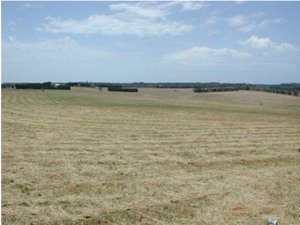CLRA36
|
| CLRA36 |  | |
| Wallington (Bawtree Road), Leopold district, Bellarine Peninsula | |||
| Undulating rises | |||
| Neogene Hanson Plain Sands: fluvial: gravel, sand, silt | |||
| Upper slope | |||
| 5% | |||
| South-east | |||
Horizon | Depth (cm) | Description | ||
A11 | 0–25 | Very dark grey (10YR3/1); sandy loam; few ferruginous coarse fragments; weak fine polyhedral structure; rough ped fabric; very weak moderately consistence (moist); pH 7.0; sharp boundary to: | ||
A12c | 25–35 | Dark yellowish brown (10YR4/4); loamy sand; apedal single grain structure; very many medium to very coarse ferruginous nodules; pH 7.0; sharp boundary to: | ||
B2 | 35–70 | Red (2.5YR4/6 moist) with medium to coarse prominent yellowish brown (10YR4/3) mottles and medium to coarse prominent brown (10YR5/6) mottles; medium clay; strong coarse angular blocky structure; smooth ped fabric; very firm moderately consistence (moist); slickenside cutans are distinct; pH 6.5; gradual boundary to: | ||
C/R | 70–135+ | Rock | ||
| Management considerations | ||||
| This site has a very strong texture contrast between the sandy loam to coarse loamy sand upper surface soil and the clayey subsoil and is a very important soil feature. This can have a major effect by reducing and/or redirecting the internal drainage and restricting root growth beyond the upper horizons. Sandy topsoils generally have poor plant water holding capacity and poor nutrient holding capacity and due to the low level of bonding between soil particles are prone to wind, sheet and rill erosion (depending on organic matter content and vegetative cover). These soils may be hydrophobic (in conjunction with organic coatings) when dry, taking time to reabsorb moisture. It is helpful to reduce the wetting/drying cycle and as well as increase organic matter. Sandy topsoils do however drain rapidly. Maintenance of a vegetative cover is important, as is the depth of organic rich topsoil for soil stability and nutrient holding capacity. The subsoil is mottled and is an indication of periodic waterlogging, particularly if the mottles are pale (low oxygen conditions). The matrix colour is predominantly red which indicates that air is reaching the subsoil for much of the time. Some brighter mottling may be due to past soil mixing and clay illuviation. Improved drainage, with the application of gypsum for sodic subsoils may be beneficial, though this site is only slightly sodic in the subsoil. | ||||
Analytical data
Site CLRA36 | Sample depth | pH | EC | NaCl | Ex Ca | Ex Mg | Ex K | Ex Na | Ex Al | Ex Acidity | FC –10kPa | PWP –1500kPa | KS | FS | Z | C | |
Horizon | cm | H2O | CaCl2 | dS/m | % | cmolc/kg | cmolc/kg | cmolc/kg | cmolc/kg | mg/kg | cmolc/kg | % | % | % | % | % | % |
B2 | 35–70 | 6.8 | 5.9 | 0.1 | N/R | 2.5 | 4.8 | 0.24 | 1.1 | N/R | N/R | N/R | N/R | N/R | N/R | N/R | N/R |



